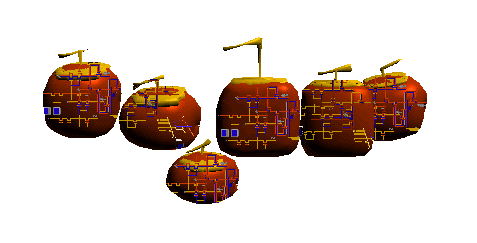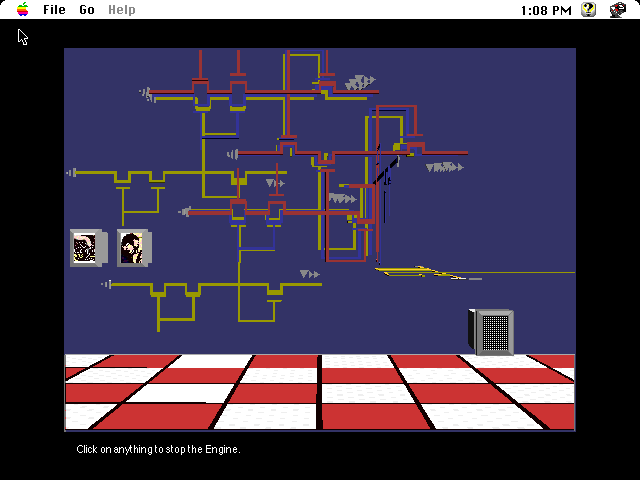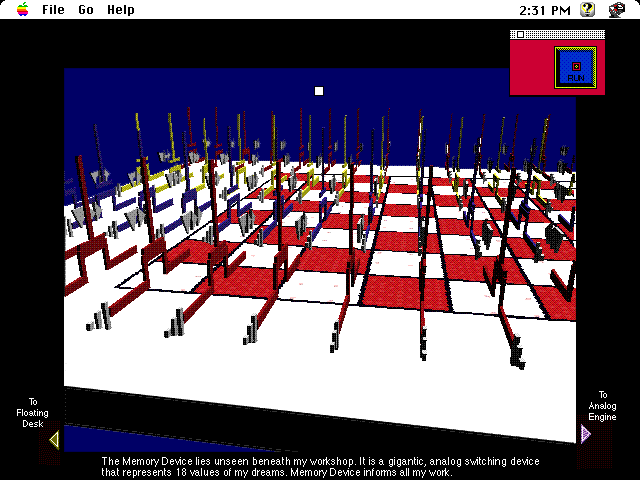Conversations with Fred Truck
on the Interactive Art Conference on Arts WireJanuary 1995/September 1995


Judy Malloy
Anna and I are delighted to welcome back our old friend Fred Truck! Fred was integral in setting up Art Com Electronic Network on the WELL in 1986. At about the same time, his seminal artists' software ArtEngine incorporated artificial intelligence into the art making process.Since Fred already introduced himself in January when he was our prototype Interactive Guest Artist, I thought I would replay our January conversation to begin this topic.
January, 1995
Fred Truck
Hi! I'm Fred Truck. I've been doing interactive computer art in a variety of formats for a number of years. I'm most interested in the process of making art. For that reason, I did a piece of artist's software called ArtEngine in the period, 1986-1991. ArtEngine takes two images given by the artist and from them, constructs a new third image. The Engine can remember this image and then combine it with other given images. The interaction here can be quite subtle, as the artist manipulates the data given the Engine to modify the program's logical process.Currently, I am working on another interactive piece. It is a 3D representation of an electronic artist's workshop, called Bottega. It features all my work, either directly or by reference, from 1975- the present.
Finally, the piece that I have done that received more attention than anything else was Labyrinth, a virtual reality art work shown at the Machine Culture art show at Siggraph '93. Labyrinth allows the user to experience the myth of Daedalus' escape from the prison of Minos using an ornithopter as I envision Leonardo da Vinci would have designed it.
In this work, the user pilots da Vinci's Flying Machine through a 4-dimensional manifold, a Klein bottle. The wings flap and creak, the machine is extremely responsive, and the pilot can look in one direction, while the ornithopter goes in another.
The Labyrinth was a project of the Studio for Creative Inquiry at Carnegie Mellon University in 1993.
I've been invited here by Judy Malloy and Anna Couey to discuss my work and the topic of interactivity. I'm really excited about this, and want to thank them for this opportunity.
Judy Malloy
Hi Fred,
it's great to see you here and hear about your work. Last night Anna was telling me that she saw your Bottega piece demonstrated when you were in town and it was really wonderful!F. John Herbert, Drawing Legion
Welcome, Fred.Judy Malloy
Fred, I've been following the art Engine for years and still have the MAc disk on which their first version appeared. Are you still working on it? How could someone experience it?Fred Truck
I'm not working on it insofar as a piece of standalone software is concerned. I have, instead, simulated it, in BOTTEGA. I have made a visual interface for the software in BOTTEGA that runs fragments of ArtEngine code and shows the user how it works.The simulation is called ANALOG ENGINE. Present in this version are the logical processes (in both code and visual form) and in a new form, called The Memory Device.

Why would I do this? The answer is that logic is a very interesting animal. It can be represented visually in the form of circuits. So by representing the logic of ArtEngine visually, and causing it to run the code, a visual interface for the Engine that runs in an ANALOG form to ArtEngine is created.
Missing in this new version, ANALOG ENGINE, are the expert systems that actually manipulated images. Instead, a very simple switching device called THE MEMORY DEVICE, which is operated by classifying input images according to 18 very subjective qualities, is used to filter out extraneous image parts and create the new third image.

In practice, this allows me to make ANALOG ENGINE much smaller than ArtEngine was. I use more of the artist's abilities--for image editing, which I had to do anyway in ArtEngine--in ANALOG ENGINE, and the result is extremely visual, both in interface and in output, whereas with ArtEngine, only the output was visual.
Additionally, I got to exercise a fantasy--what kind of computer could I actually build to do my art?
Judy Malloy
I really like the idea of having all your work available through Bottega. A problem with interactive computer art has been that platforms become obsolete and it is hard to access some of the seminal works these days.So what is your fantasy art making computer like?
Fred Truck
My fantasy is actually conceptual. The computer itself is very simple. It is 4 banks of 18 switches. The first bank represents a target image. The switches in the first bank represent the 18 classifications an image has, according to my concepts. If an image has a particular quality, the switch is turned on. If not, the switch is off.The second bank represents another image, and the 18 switches are on or off according to the qualities of that image.
Current is run from one bank to another, so the process is a subtractive process, rather like sifting earth with progressively smaller and finer sieves. In the last bank, the target image and the secondary image are combined...that is, the current has been reduced so that only the switches that are on are conducting. This current represents the new image.
It's a very simple switching device. Transistors and gates can be represented visually any number of ways. I've read about a conceptual computer that could be made with ropes and pulleys. Logic can be imbedded in very physical objects. I have found this notion to be very useful in representing the process by which I make art.
Valerie Gardiner
Hi Fred! That Labyrinth sounds really cool!Anna Couey
Hi Fred!!! Thanks for joining us in interactive!Like Judy, I've had long discussions with you about Art Engine...& The logic in both ArtEngine & Analog ArtEngine is the process of thesis/anti thesis/synthesis? How do the expert systems in the original software differ from Analog ArtEngine's sifting of the subjective categories? And what are the subjective categories?
In your fantasy computer, does the artist feed the source images? Does the artmaking computer make anyone who feeds it images an artist? Does it find images on its own?
Fred Truck
Lots of questions. Ok, the 18 categories are:
1. desert
2. blue & yellow
3. youth image
4. Sun
5. ouroboros
6. heart beat
7. breath
8. death
9. center of the world
10. twins
11. bowls or pitcher
12. water
13. art, games, ritual, music
14. perspective
15. caduceus
16. transformation, animation 17. my twin
18. a cloudy blue
Yes, the logic in ArtEngine can be explained by thesis - antithesis - synthesis. The expert systems were a method of doing some of the image editing. For example, it is easy to write an expert system that scales images or parts of images. ArtEngine had such an expert system.The problem with ArtEngine was that the artist still had to do image editing anyway. I was never able to completely eliminate handwork.
In ANALOG ENGINE, I just accept that fact (for now). What The Memory Device in ANALOG ENGINE does is determine which parts are in and which parts are out of the new, third image. ArtEngine also did that, but it was by a computational technique called the association list. ANALOG ENGINE is a circuit, or collection of circuits. Everything is hardwired.
There is no code, except that...
What I did was digitally simulate a hardwired machine. So there is code, but it is used to simulate a hardwired machine. And the machine embodies the logic of an artistic process.
Currently, what I have is a simulation. ANALOG ENGINE has the potential to be as flexible as ArtEngine, but currently it isn't, because I want a demo type thing in Bottega, not the actual machine--thus the simulation. Currently, ANALOG ENGINE does not find images on its own.
I approach the question of who is the artist from a different angle. The machine represents me through process. The operator of the machine thus is more like a very active viewer, or a patron--at least in current versions. The patron can specify which images and which combinations. In future versions, if the patron brings images parts, the situation remains pretty much the same because for it to work, the images must relate minimally to one or two of the 18 categories above.
Timothy Collins
Hi Fred, artswire score Judy! great stuff, gonna download and indulge a bit!
Tell us more!Fred Truck
So the overall concept of Analog Engine is to use the computer to digitally simulate an analog computer that is specifically hardwired to my artistic process.The visual component of the simulation uses graphic representations of logic circuits, so it is in no way just a mask for the digital code, which makes things happen. It is the visual side of the code in analog form.
Judy Malloy
Ah - the visual side of the code which brings us to the question is the code itself art....Fred Truck
I have mixed feelings about this. I think sometimes the code is the art, if what is being done is the art. If it is a matter of opening files, or something that is computer maintenance, then probably not. Then again, if opening files is a part of the art, maybe so. In terms of writing the code, there are no doubt some languages, such as LISP and SCHEME that are very haiku-like. It is not a matter of elegance, so much as a matter of being a representation of symbol manipulation that creates the poetry--how things in the code can represent other things. This type of stuff can really be beautiful. Unfortunately, at this time it is available only to others who program the language, and to those who have the source code.Judy Malloy
One of the interesting things about constructing Brown House Kitchen on LambdaMoo which uses an object oriented programming language that Pavel Curtis wrote that is kind of a cross between C+ and LISP was how the programming process had to integrate with the art making. The things in the kitchen are, like other things one creates in this environment, called objects and in order to program you have to "get" them . So, if I want to work on the narranoter, forinstance, I first have to open the drawer and then take out the noter (all virtually of course) which really makes me feel like I'm working on a piece of sculpture.